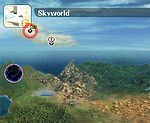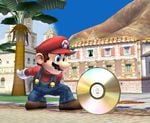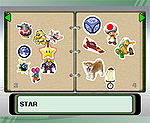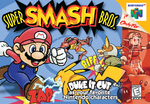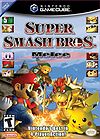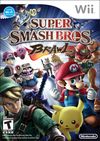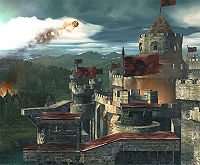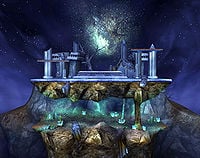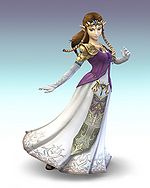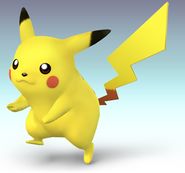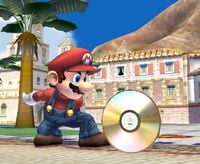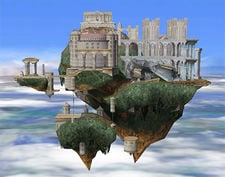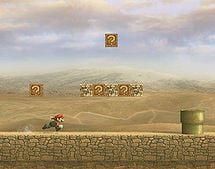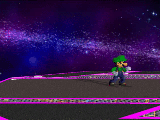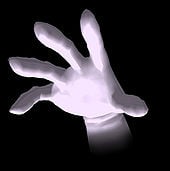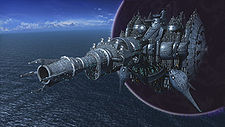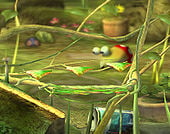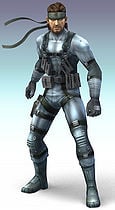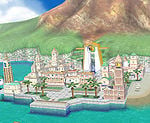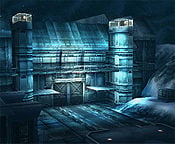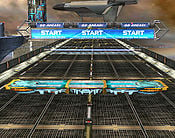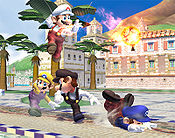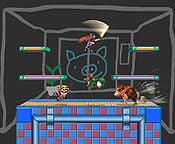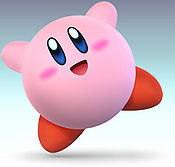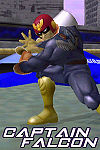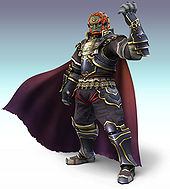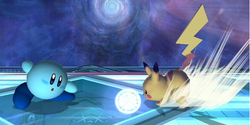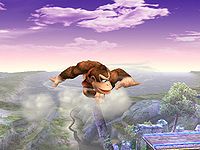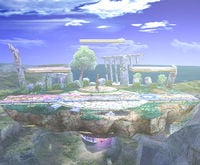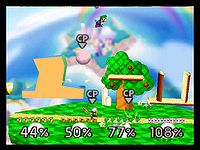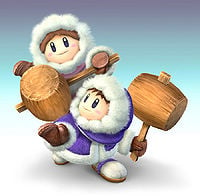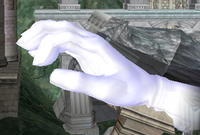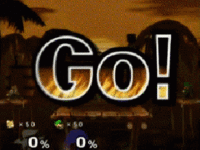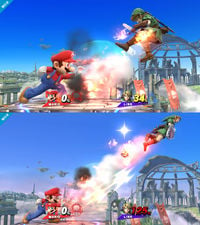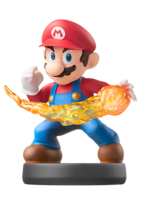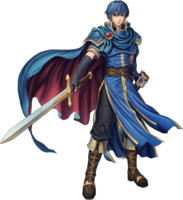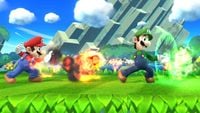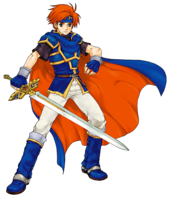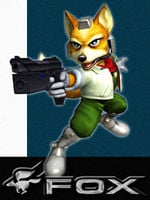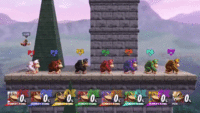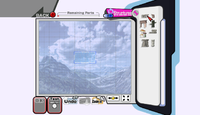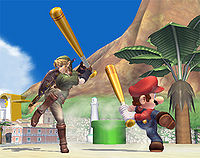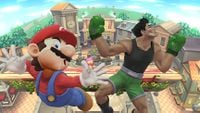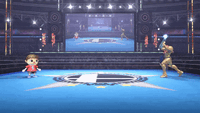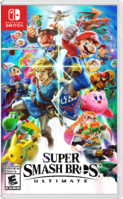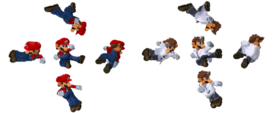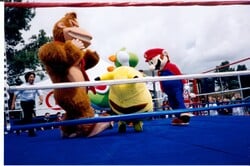SmashWiki:Featured content/Full
The following is the sample text of each of the current featured article texts.
| Featured Articles | ||||||||||||||||||||||||||
|---|---|---|---|---|---|---|---|---|---|---|---|---|---|---|---|---|---|---|---|---|---|---|---|---|---|---|
| 1 |
As confirmed on Smash Bros. DOJO!!, Super Smash Bros. Brawl will feature a new single-player adventure mode called the Subspace Emissary. Sakurai stated that, although the past games featured a large multi-player mode, they've never created an extensive single-player adventure. more...
|
[edit] | ||||||||||||||||||||||||
| 2 |
My Music is an option in Super Smash Bros. Brawl that allows you choose a song from a particular franchise for any stage and adjust the likeliness that song will appear in that stage when you do battle in it. This feature appears in the Options sub-menu. read more...
|
[edit] | ||||||||||||||||||||||||
| 3 |
On August 15, 2007 Masahiro Sakurai updated on the Smash Bros. DOJO!! that Stickers are new collectible items that will be included in Super Smash Bros. Brawl. The inclusion of stickers sparked debates everywhere that discussed the possibility of stickers replacing the famous Trophies, but they have not. read more...
|
[edit] | ||||||||||||||||||||||||
| 4 |
The Battleship Halberd is a new stage appearing in Super Smash Bros. Brawl, based on Meta Knight's ship from the Kirby series. The fighting begins in a hangar on the ground with the Halberd in the background, but the Halberd soon takes flight and two platforms come out of the ground to follow it. read more...
|
[edit] | ||||||||||||||||||||||||
| 5 |
A Final Smash is a new feature in Super Smash Bros. Brawl. The final smash is character-specific and is incredibly powerful. It is probably the character's strongest move, and all characters have a different final smash. These attacks range from Mario's Mario Finale, where he shoots a huge wave of fire from his hands, to Pit's Palutena Army, where he summons flying Centurions to attack his opponents. If properly executed a Final Smash always has the capacity to KO at least one opponent. The only way to perform a Final Smash is to press the special move button after destroying a Smash Ball or acquiring a "Pity Final Smash". The Pity Final Smash is a Final Smash given to a character when he or she is far behind in points, upon being revived he or she will be in stand-by mode. Multiple Smash Balls can appear in a match, but not at the same time. (read more...)
|
[edit] | ||||||||||||||||||||||||
| 6 |
Super Smash Bros., known in Japan as Nintendo All-Star! Great Fray Smash Brothers, is a crossover fighting game developed by HAL Laboratory and published by Nintendo for the Nintendo 64 console. It was first released in Japan on January 21, 1999, and released on April 27, 1999 in North America, followed by November 19, 1999 in Europe. (more...) |
[edit] | ||||||||||||||||||||||||
| 7 |
Super Smash Bros. Melee is the sequel to the 1999 Nintendo 64 fighting game Super Smash Bros.. Like its predecessor, Super Smash Bros. Melee is different from traditional fighting games in that inflicting damage does not guarantee victory. In play, a player must force the opponent beyond the stage's boundaries, referred to as a "Knock-Off" and abbreviated in the game as a KO. read more...
|
[edit] | ||||||||||||||||||||||||
| 8 |
Super Smash Bros. Brawl is the third installment in the Super Smash Bros. series published by Nintendo to be released on the Wii. Brawl, as with the other games in the series, features a diverse roster of characters from Nintendo and its second parties to fight in various kinds of matches. However, Brawl is the first Super Smash Bros. game to feature third-party characters. (more...)
|
[edit] | ||||||||||||||||||||||||
| 9 |
Castle Siege is a stage in Super Smash Bros. Brawl from the Fire Emblem universe. Unlike many universe based stages, Castle Siege is not based on any single event in the games, but on a combination of themes in the games. The stage is also unique in that it is actually three different stages that cycle through each other during the match. The stage beings on the top of the castle, but quickly descends into the interior of the castle. Here, the players find an opulent room complete with destructible statues. Eventually, the players descend to the area below the castle where a single flat platform above a poll of lava is all there is to battle on...(more)
|
[edit] | ||||||||||||||||||||||||
| 10 |
Spear Pillar is a stage that debuted in Super Smash Bros. Brawl. Hailing from the Pokémon Universe, Spear Pillar is a location in Pokémon Diamond and Pearl where the player battles Dialga or Palkia. As a playable stage, Spear Pillar is two platforms roughly the size of the base of Battlefield, one on top of the other, with two smaller platforms moving up and down above them. What sets this stage apart from other stages is the presence of the Pokémon. After the battle beings, Dialga, Palkia, or Cresselia appears and beings to mess with the players. Dialga and Palkia create beams of energy to attack the players, as well as causing temporal shifts in time and space. Cresselia instead creates sickles that fly around the stage, causing large knockback to any character they hit...(more) |
[edit] | ||||||||||||||||||||||||
| 11 |
Zelda is a returning character in Super Smash Bros. Brawl. Originally from the Legend of Zelda Universe, Zelda is the princess of the kingdom of Hyrule. As a fighter, Zelda fights with her magic attacks, presumably endowed from her possession of the Triforce of Wisdom. These magic attacks tend to require precision on the part of the player, especially her aerial attacks. Her aerials have extremely small (in both size and frames) sweetspots. If she misses these sweetspots, the attacks are incredibly weak; but if the sweetspot hits, they are among the most powerful attacks in the game. Due to the high knockback of most of her attacks, Zelda players rely less on combos and more on tech-chasing and edgeguarding. For edgeguarding, Zelda wields one of the most effective projectiles in the game: Din's Fire. Unlike many attacks, Din's Fire becomes stronger and larger the farther it travels. Zelda is also able to transform into Sheik if the situation requires...(more) |
[edit] | ||||||||||||||||||||||||
| 12 |
Pikachu is the most famous species in the Pokémon Universe. Resembling a yellow rodent, Pikachu's most defining characteristics are his red cheeks and his lightning bolt shaped tail. As the tail implies, Pikachu is an electric type Pokémon. In the original Pokémon games, Pikachu was simply a normal catchable Pokémon. Its popularity grew not from its role in the games, but from its role in the anime series. Here, it served as the primary Pokémon of protagonist Ash Ketchum because he woke up too late to get Squirtle, Bulbasaur, or Charmander from Professor Oak. In the Super Smash Bros. series, Pikachu is one of only two Pokémon to appear as playable characters in all three games (the other being Jigglypuff). Pikachu enjoyed a large amount of play during the original Super Smash Bros., resulting in his top placing in that game's tier list. In the later games, Pikachu continued to fight, and in Melee his pre-evolved form, Pichu, joined him...(more) |
[edit] | ||||||||||||||||||||||||
| 13 |
Compared to previous games in the Super Smash Bros. series, the music of Super Smash Bros. Brawl has a much larger significance to overall gameplay. Where Brawl's predecessors had no more than two songs per stage, some stages in Brawl, such as Halberd, have as many as twelve. Brawl director Masahiro Sakurai stated on the Smash Bros. DOJO!! that his group of arrangement supervisors were asked to listen to "an elite selection of Nintendo music" and arrange several of their favorite songs, which "means there will be quite a number of songs." In fact, there are 258 different songs one can listen to in the game's Sound Test feature. However, not all of these songs are available from the start; many require unlocking or are collectible CDs... (more) |
[edit] | ||||||||||||||||||||||||
| 14 | Meta Knight is a playable character in the third installment of Super Smash Bros. Originating in the Kirby universe, Meta Knight is a small, ball shaped, fighter with wings and a short sword. Meta Knight is a fast fighter, with many quick, low knockback attacks allowing him to set up many combos and rack up damage. In particular, his Mach Tornado can quickly do up to 26% damage and leave Meta Knight almost immediately ready to attack again. His low cooldown time and speedy attacks come at a small price, however; Meta Knight is quite limited in the area of finishing moves. He is basically limited to his forward and down smashes and/or his Shuttle Loop. Beyond this, Meta Knight can use his incredible jumping potential (granted by his wings) to gimp opponent's recoveries for additional kills. These disadvantages, however, are often overcome simply by Meta Knight's ability to dominate the tempo of the game. On the current tier list, Meta Knight is ranked first, mainly due to his dominating play style and his favorable match-ups against many characters. (more...) | [edit] | ||||||||||||||||||||||||
| 15 |
Temple is a stage that debuted in Super Smash Bros. Melee and it appears again in Super Smash Bros. Brawl as a Melee Stage. It is based off of The Legend of Zelda series, specifically Zelda II: The Adventure of Link. It is also commonly known as Hyrule Temple, though the "Hyrule" technically denotes its stage location. It is notoriously large; in fact, the only stage to rival its size is New Pork City. Despite having no stage hazards, the stage is almost always banned from tournaments due to its size. Its My Music selection in Brawl is unique in that it includes a new music track, entitled Great Temple / Temple. The stage also has given rise to such tricks as the Hyrule Jump... (more...) |
[edit] | ||||||||||||||||||||||||
| 16 |
Mushroomy Kingdom is a stage in Super Smash Bros. Brawl from the Mario universe. It is based off of the iconic level 1-1 of the original Super Mario Bros., though the background has been changed to that of a sweeping desert reminiscent of New Super Mario Bros. The layout of the original level has been preserved through the inclusion of such things as Warp Pipes and ? Blocks, which even release items when attacked. Its side-scrolling motion and extremely shallow blast lines are the main reasons it is banned in tournaments. Additionally, the stage has a 50-50 chance of loading a similar stage based off of the underground 1-2, also of Super Mario Bros... (more...) |
[edit] | ||||||||||||||||||||||||
| 17 |
Tabuu is the final boss of The Subspace Emissary in Super Smash Bros. Brawl. His name is a pun on the English word "taboo," meaning unacceptable and improper. As the embodiment of Subspace itself, his villainous goal is to pull the World of Trophies into Subspace, piece by piece. He leads the Subspace Army, which he formed out of Shadow Bugs. He also manipulated the Ancient Minister and Master Hand to serve his goals. Tabuu's plan was only thwarted at the last minute by preparations made by King Dedede. He created The Great Maze out of the pieces of the World of Trophies that were pulled into Subspace by the Subspace Bombs... (more...) |
[edit] | ||||||||||||||||||||||||
| 18 |
Wavedashing is a technique in Super Smash Bros. Melee involving the usage of a directional air dodge to slide along the ground. Popularly considered a glitch, it is in fact merely an exploitation of the game's physics engine. Wavedashing is considered one of the most important advanced techniques in Melee and is especially important for characters like the Ice Climbers and Mewtwo in competitive play. Wavedashing cannot be performed in Super Smash Bros. Brawl due to the removal of directional air dodges. (more...) |
[edit] | ||||||||||||||||||||||||
| 19 |
Master Hand is a recurring boss in all three games of the Super Smash Bros. series. He has been the boss of the 1P Game or the similar Classic Mode, and in Melee and Brawl he is sometimes paired with his opposite, Crazy Hand. His stamina must be depleted to defeat him. No matter what game he is in, he is always fought on some version of Final Destination. Master Hand also appears in The Subspace Emissary in Brawl. He is controlled by Tabuu through the Chains of Light and is used as a subordinate in the Subspace Army. Eventually Master Hand attacks Tabuu, but is defeated. Master Hand is never legally playable... (more...) |
[edit] | ||||||||||||||||||||||||
| 20 |
The Subspace Gunship is the greatest weapon of the Subspace Army. It was assembled in Subspace, and entered the World of Trophies through what used to be the Isle of the Ancients. The ship's main weapon is a large cannon that fires an intense purple beam; on contact, the effects are similar to the detonation of a Subspace Bomb. The Gunship also has smaller turrets for shooting down other ships; these were used to destroy the Halberd. The Gunship was commanded by Bowser and Ganondorf before it was destroyed by Kirby using the Dragoon. (more...) |
[edit] | ||||||||||||||||||||||||
| 21 |
The Assist Trophy is a new item in Super Smash Bros. Brawl. Functioning much like Poké Balls have in all three Super Smash Bros. games, the Assist Trophies randomly releases one of many available helper characters. Unlike the Poké Ball item, however, an Assist Trophy character can be from any universe, not simply the Pokémon universe. While some of the characters come from established universes, such as Waluigi from the Mario universe, a few are from otherwise unrepresented universes, such as Helirin. Some Assist Trophy characters must be unlocked before they will appear during gameplay. (more...) |
[edit] | ||||||||||||||||||||||||
| 22 |
Distant Planet is a stage in Super Smash Bros. Brawl representing the Pikmin series. As such, it is the home stage of Olimar and his Pikmin. Set on the otherwise unnamed Pikmin home planet, the stage consists of a slanted hill on the left and a series of vines and leaves in the center. The plant-based platforms are slightly bouncy. Occasionally, a Bulborb will walk up on the right side of the stage, and landing on its head or in its mouth will likely result in a self-destruct as it drags the character beyond the blast line. Rainstorms will also occur, causing a rush of water down the hill. (more...) |
[edit] | ||||||||||||||||||||||||
| 23 |
Snake is a newcomer to the Smash series in Super Smash Bros. Brawl. The sole representative character of the Metal Gear, he was the first confirmed third-party character for Brawl, later joined by Sonic. Snake's playstyle depends heavily on his various projectiles, including his up and down smash attacks. In fact, all four of Snake's special moves can be used as projectile attacks. Snake is also heavyweight, making him harder to KO, and his crawl allows him to dodge many projectiles. These attributes, along with a multitude of high-knockback moves, are the primary reasons Snake is ranked 2nd on the current Brawl tier list. (more...) |
[edit] | ||||||||||||||||||||||||
| 24 |
Delfino Plaza is a starter stage in Super Smash Bros. Brawl representing the Mario universe. The stage is based off of the town on Isle Delfino of the same name in Super Mario Sunshine. A moving platform will move the characters around various locations around the town, including islands, rooftops and the ground of the town itself. Many sections of the stage include water, allowing characters to swim. The music for this stage comes from Super Mario Sunshine, Super Mario World, New Super Mario Bros. and Super Mario 64. (more...) |
[edit] | ||||||||||||||||||||||||
| 25 | left|180px|
Smashtasm is perhaps the most famous machinima series created using Super Smash Bros. games. Created for YouTube by Shippiddge, the first season uses Super Smash Bros. Melee and the second season uses Super Smash Bros. Brawl. The plot primarily follows the actions of a Mario player named Super64 and his adventures through a fictional server-based system for online Smash play. The Melee season was created using both Camera Mode and an Action Replay. Smashtasm went on to be publicized by machinima.com. (more...) |
[edit] | ||||||||||||||||||||||||
| 26 |
Shadow Moses Island is the sole stage representing the Metal Gear universe in Super Smash Bros. Brawl. The stage resembles the area of the helipad outside of the facility on the island, dating back to its appearance in Metal Gear Solid. Two walls dominate the sides of the stage, though they can be destroyed to allow access to the side blast lines and as such alternate means of KO-ing opponents. Metal Gear REX, Metal Gear RAY and GEKKOs can all appear in the background of the stage, though they don't affect the battle. This stage is home stage to Solid Snake, who is unlocked by playing on the stage. It is also the only place where Snake can use his codec. (more...) |
[edit] | ||||||||||||||||||||||||
| 27 |
Port Town Aero Dive is the stage in Super Smash Bros. Brawl representing the F-Zero universe and as such is home stage to Captain Falcon. It is a recreation of the racetrack of the same name from F-Zero GX, and parallels many stage effects introduced in the Mute City stage in Super Smash Bros. Melee. A single platform carries characters around the track, stopping off randomly in one of many locations, each of which causes a different layout. Many cause vulnerability to F-Zero vehicles, which cause high amounts of damage and knockback. (more...) |
[edit] | ||||||||||||||||||||||||
| 28 |
In Super Smash Bros. Brawl, almost every character has six different palette swaps. Every character has red, green and blue color schemes for usage in team battles. Many palette swaps are references to other characters or older color schemes for the selected character, such as Toon Link's alternate green costume. Other colors often include white, dark, gold and other colors. Only characters from the Pokémon games and Sonic lack six variations. (more...) |
[edit] | ||||||||||||||||||||||||
| 29 |
WarioWare, Inc. is a starter stage in Super Smash Bros. Brawl representing the Wario universe and as such is the home stage to Wario. While fighting, characters often will have to participate in microgames based on those found in WarioWare games. Successfully completing these will benefit the character through invincibility, damage reduction or other positive effects. However, the randomness of both the microgames themselves as well as their rewards makes the stage banned in the standard tournament ruleset. (more...) |
[edit] | ||||||||||||||||||||||||
| 30 |
Kirby is a fighter in Super Smash Bros. Brawl who has also appeared in both of the previous Super Smash Bros. Kirby hails from a long series of games of which he is the namesake. He is a small pink ball with stubby arms, large feet, and a cute face. As a fighter, Kirby battles with a variety of punches and kicks, as well a a large hammer. He is also able to Inhale enemies to copy their abilities or to perform a Kirbycide. Kirby's recovery is helped by five midair jumps, and his Final Cutter, while providing almost no horizontal distance, gives great vertical recovery. His Final Smash, Cook Kirby, allows him to cook opponents in a large pot, dealing damage as well as creating food and other items. Due to his good match-ups and overall strong play, Kirby is ranked in the A tier at 13th.(more...) |
[edit] | ||||||||||||||||||||||||
| 31 |
A tier list is a ranking compiled by the Smash Back Room of SmashBoards to summarize the overall relative metagame potential of the various characters throughout the Smash Bros. series. The lists are divided into "tiers" which group similarly-viable charcters together, hence the name. Tier list rankings are based off of the status of a character's metagame, tournament placings, and matchups; all assuming high-level play and standard tournament rulesets. The current top-ranked characters are Pikachu for SSB, Fox for Melee, and Meta Knight for Brawl. Tier lists are often controversial within the Smash community: the placements themselves are hotly debated, and the list as a whole is often misunderstood. (more...) |
[edit] | ||||||||||||||||||||||||
| 32 |
Captain Falcon (キャプテン・ファルコン, Kyaputen Farukon) is a starter character in Super Smash Bros. Melee, famous for his running speed, falling speed, combo ability, and the knee. Captain Falcon is well known for his extreme speed and combo ability. His dash speed is the fastest in the game, his air speed is fast, and his falling speed is very fast. His fast falling speed allows him to SHFFL very well, and it gives him resistance to vertical KOs. However, it also shortens his recovery and makes him easy to combo and chaingrab (especially since he is heavy and large). His running speed and high lateral air speed give him the game's longest and fastest long jump, allowing him to close great distances with short hop aerials and edge-guard faraway enemies. He also has the best dashdance and moonwalk in the game. (more...) |
[edit] | ||||||||||||||||||||||||
| 33 |
Ganondorf (ガノンドロフ, Ganondorofu) is an unlockable character in Super Smash Bros. Brawl. First depicted in the Zelda universe, Ganondorf is the main villain in the Zelda series and beings as a member of the Subspace Army in The Subspace Emissary. As a fighter, Ganondorf is one of the strongest, heaviest, and slowest characters in the game. The majority of his attacks are slow one-hit power blows with incredible knockback, giving him a wide array of KO moves. However, his lack of all-around speed, approaches, and multi-hit moves are detrimental to the fast-paced world of competitive play, making Ganondorf rock bottom on the tier list. (more...) |
[edit] | ||||||||||||||||||||||||
| 34 |
Priority is a property of hitboxes in the Super Smash Bros. series that defines their behaviour when interacting with other hitboxes. The mechanics of normal priority state that two attacks will cancel each other out if they deal similar damage (within 8%), whereas otherwise one attack will overpower and go through the other - aerial attacks, however, are not completely interrupted. Certain hitboxes also have transcendent priority, which prevents them from colliding with other attacks, for example, the hitboxes of Fox's lasers cannot be canceled by attacks. The term "priority" is often - technically incorrectly - used as a measure of an attack's hitbox location and timing. (more...) |
[edit] | ||||||||||||||||||||||||
| 35 |
Momentum canceling is a technique employed in Super Smash Bros. Brawl that is important in competitive play. The technique involves executing certain actions to halt or reduce the aerial momentum of a character that is knocked into the air. Since, in Brawl, aerial attacks and air dodges can be performed while tumbling and reeling, it is possible to use these moves, in combination with others, to slow a character's aerial movement, and avoid crossing blast lines and being KOd. Prominent examples of momentum canceling moves include Mr. Game & Watch's Oil Panic and Donkey Kong's Spinning Kong. (more...) |
[edit] | ||||||||||||||||||||||||
| 36 | Platforms are the basic building blocks of all stages in the Smash series. The four main classes of platforms are hard, semisoft, soft, and supersoft. Ledges from which characters can hang or, in Brawl, tether, can occur on any of the first three types, though they are most commonly found on the ends of hard platforms. Platforms can also possess a wide variety of other characteristics, such as rotation, weight sensitivity, destructibility, and more. Some items and special moves interact with platforms in more complex ways as well, such as a Hothead's ability to circumnavigate many platforms. (more...) | [edit] | ||||||||||||||||||||||||
| 37 | Battlefield is a Super Smash Bros. Brawl stage that was first confirmed at E3 in 2006. Its layout is very similar to that of its Melee counterpart - it consists of a central hard platform with ledges that may be hung from, and three stationary soft platforms that float above the hard platform. The stage elements are larger than those of Melee's Battlefield, and the blast lines that surround them are situated further away. The slopes on the stage's underside, beneath the ledges, can be "hugged", allowing many characters to more easily and more flexibly recover from offstage. (more...) | [edit] | ||||||||||||||||||||||||
| 38 | Like many games, there are many beta elements in the games of the Super Smash Bros. series. Beta elements come in two forms. The first form is the "pre-release" form, where early screenshots and trailers of a game showcase content that is eventually changed or removed in the final version of the game. The second form is the "unused data" form, where a game's final release contains unused information, such as unused textures, models, sounds, and so on; in some cases evidence can be found for scrapped stages or even characters. (more...) | [edit] | ||||||||||||||||||||||||
| 39 | The Ice Climbers (アイス クライマー, Aisu Kuraimā) are a starter character in Super Smash Bros. Brawl. Mostly unchanged in gameplay from their Melee selves, the player directly controls Popo while Nana mimics his actions a split-second later. The duo's two-in-one gimmick gives them a surprisingly large damage output and a huge bag of tricks, mostly through the use of desynching in order to control the two individually and set up a plethora of chaingrabs that in the hands of an expert is basically equal to a KO. Despite being vulnerable should the secondary Climber be KO'd, the constant threat of 0-death chaingrab shenanigans puts the Ice Climbers 2nd on the current tier list. (more...) | [edit] | ||||||||||||||||||||||||
| 40 | The Master Hand glitch is a glitch in Super Smash Bros. Melee. Based on the Name Entry glitch, it allows the player to freely use and control Master Hand on any stage; while any player slot allows selection of Master Hand in this way, only when in player 3's slot can he be controlled. As the game offers no special treatment to Master Hand in regular matches (giving him a damage percentage like all other characters), he cannot lose a non-Stamina match, as he is immune to knockback and can never get KO'd by crossing a blast line. The glitch is somewhat notorious for how long it took to discover - it was not publicized until June 2009, almost eight years after Melee's release. (more...) | [edit] | ||||||||||||||||||||||||
| 41 | Artificial intelligence, abbreviated as AI, in the Super Smash Bros. series refers to the intelligence of any computer-controlled (CPU) character (called computer players in-game) in the single-player and Versus Modes. In Versus Mode, players can preset the AI of a computer player, with a level setting between 1 to 9, with a higher level resulting in more competent AI. In Adventure Mode, All-Star Mode, and Classic Mode, players can still set it to some degree, via the mode's respective difficulty setting, where a higher difficulty results in the mode having more competent AI. The AI in Smash is notorious for how flawed it is however, especially in Smash 64 and Melee, where the AI plays in a generally poor predictable manner, as well as having many specific flaws and quirks human players can easily take advantage of. (more...)
|
[edit] | ||||||||||||||||||||||||
| 42 | Knockback is a measure of how far an attack sends its target, with the amount of knockback a player receives increasing as their damage accrues. For example, Bowser's forward smash is an attack of high knockback; it launches opponents very far, so far that at extreme high damages it's more powerful than a Home-Run Bat's smash attack. Pikachu's neutral attack, on the other hand, has very low knockback - it hardly sends opponents anywhere, even at ludicrous damages. In addition to damage, how much knockback a character sustain is primarily determined by their weight, with heavier characters sustaining less knockback, though factors such as gravity can also play a role in determining knockback received. There are two values of knockback; base knockback, which is how much knockback is dealt at 0% damage, and knockback scaling, which is how much an attack's knockback increases as damage is accrued. Some attacks also have set knockback, where the attack will always deal the same knockback regardless of the opponent's damage. (more...)
|
[edit] | ||||||||||||||||||||||||
| 43 | amiibo are a line of interactive figurines available for usage with the Wii U and Nintendo 3DS, and both versions of Super Smash Bros. 4 are compatible with them. Every playable character in SSB4 is represented in amiibo form, including characters that are available as downloadable content. Scanning in an amiibo allows players to customize an individual CPU fighter, known as a Figure Player, or FP. amiibo characters can level up over time, becoming stronger and learning their opponents' playstyles in broad strokes. amiibo can also reward their owner with gift items like custom parts and trophies.
(more...)
|
[edit] | ||||||||||||||||||||||||
| 44 | Marth is the main playable hero in the first and third installments of the Fire Emblem series of tactical role-playing games. Previously well-known primarily in Japan for a game series that was never localized abroad, Marth was included in all language versions of Super Smash Bros. Melee as a playable character, and his popularity in the game (along with that of his similar counterpart Roy) influenced Nintendo's decision to release all subsequent Fire Emblem titles (excluding New Mystery of the Emblem) internationally.
(more...)
|
[edit] | ||||||||||||||||||||||||
| 45 |
Fireballs (ファイアボール, Fireball) are small projectiles launched by Mario and Luigi as their neutral special moves. Each travels a short distance, does minor damage, and causes flinching common to fire-based attacks. The fireball's trajectory changes according to the stage's surface angle upon contact, though with different results for each character. (more...)
|
[edit] | ||||||||||||||||||||||||
| 46 |
Roy (ロイ, Roy) is the protagonist of Fire Emblem: The Binding Blade, the sixth game in the Fire Emblem series of tactical role-playing games. His debut in Super Smash Bros. Melee along with Marth increased global interest in the series, prompting future titles to be released internationally from the seventh installment onwards. (more...)
|
[edit] | ||||||||||||||||||||||||
| 47 |
Announced at E3 2001, Fox (フォックス, Fox) is a playable starter character in Super Smash Bros. Melee. He is emblematic of speed and he can dominate foes with his rapid attacks, quick movement and overpowering offense in all areas of his game. He is placed 1st on the Melee tier list due to these advantages. True to his position, Fox is an extremely efficient fighter with fast attacks, excellent comboing and damaging ability, long recovery options, and numerous approaching methods boasting some of the best neutral game options among the entire cast. (more...)
|
[edit] | ||||||||||||||||||||||||
| 48 |
Super Smash Bros. 4 (also referred to by shorthands such as Smash 4, SSB4, or more informally Sm4sh, and officially as Super Smash Bros. for Nintendo 3DS / Wii U) is a term used to collectively refer to Super Smash Bros. for Nintendo 3DS and Super Smash Bros. for Wii U, two games in the Super Smash Bros. series created by Bandai Namco and Sora Ltd. However, in an interview with Kotaku, Masahiro Sakurai has stated he considers the 3DS version the fourth installment and the Wii U version the fifth installment. The games feature mostly identical gameplay, but with several differences in other areas. The 3DS version is the first game of the series to be released on a handheld. (more...)
|
[edit] | ||||||||||||||||||||||||
| 49 |
Stale-move negation, also known as Repetition Effect in Super Smash Bros. 4, is a gameplay element in all games in the Super Smash Bros. series. It refers to how moves cause less damage and knockback as they are used multiple times in a row. The strength of a move increases back to its regular power as other moves are used. Starting in Melee, being KO'd resets the staleness of all of that player's moves. Moves not yet affected by stale-move negation are referred to as fresh. Moves are only affected by stale-move negation if they connect with an opponent or other object that can take damage. (more...)
|
[edit] | ||||||||||||||||||||||||
| 50 |
The Stage Builder (ステージ作り, Stage Maker) is a feature in Super Smash Bros. Brawl, Super Smash Bros. for Wii U, and Super Smash Bros. Ultimate that allows players to create their own custom stages by using the given stage parts, and in Super Smash Bros. for Wii U and Super Smash Bros. Ultimate's case, drawing on the GamePad and the Nintendo Switch, respectively. Players can also choose from a variety of backgrounds and pick any song on the games' soundtracks. (more...) |
[edit] | ||||||||||||||||||||||||
| 51 |
The Home-Run Bat (ホームランバット, Home Run Bat) is a battering item in all four Smash Bros. games. It is best-known for its one-hit KO potential. While the Home-Run Bat functions like regular battering items, it has the unusual property of completely altering the character's forward smash. Upon performing a forward smash, the character winds up and uses an extremely powerful attack that can potentially KO opponents in a single hit. The attack always takes a set amount of time and cannot be charged, making it the only such item to alter this mechanic in players. (more...) |
[edit] | ||||||||||||||||||||||||
| 52 |
A Screen KO (手前やられ, Forefront defeat) is a special type of KO which has a chance of occurring when characters are launched past the upper blast line. In contrast of a Star KO, the character instead falls into the foreground and appears to crash into the television screen, before they are KOed at the bottom. Whether a character is Star KOed, Screen KOed, or merely blast KOed is mostly random. In the first three games, Screen KOs are considerably rarer than Star KOs- as a result, Screen KOs rarely involve two or more characters at once. In the fourth game, the frequency of Screen KOs has been increased, especially in the 3DS version, to be about as common as Star KOs. (more...) |
[edit] | ||||||||||||||||||||||||
| 53 |
Pocket (しまう/とり出す, Store Away/Take Out) is Villager's neutral special move. When Pocket is activated, the Villager is given a few frames of intangibility, and will reach out a short distance forwards in an attempt to grab any item or projectile within range, which is then put into storage. Items can be pocketed even in circumstances where they cannot be picked up normally, such as after a Bumper or Spiny Shell has been activated. Using the move again will retrieve the stored object. While projectiles are generally pocketable if they are reflectable, they must also be detached from their user and have their own graphical model (as opposed to being a collection of particle effects), so some projectiles may not be pocketable even though they look like they should be (such as Din's Fire). (more...) |
[edit] | ||||||||||||||||||||||||
| 54 |
Super Smash Bros. Ultimate (大乱闘スマッシュブラザーズ SPECIAL, Great Fray Smash Brothers Special) is a fighting game for the Nintendo Switch. It was first announced on March 8th, 2018 at the end of the Nintendo Direct released the same day. It is the fifth installment in the Super Smash Bros. series (sixth if both versions of Super Smash Bros. 4 are counted as two games). The game was released on December 7, 2018. (more...) |
[edit] | ||||||||||||||||||||||||
| 55 |
A clone (officially Echo Fighter (ダッシュファイター, Dash Fighter) for certain clones in Ultimate) is a character whose moveset, animations, and general properties are mostly derived from another character, as opposed to being unique to them. All clones have some sort of gameplay difference from their parent character, ranging from different animations (such as with Daisy) to fully unique moves (such as with Chrom), but on the whole, they will generally be very similar to their parent, to the point where a casual player might play either in the same way, and even competitive players will often play both a clone and their parent character. However, this is not to say that playing a clone like their parent will be successful; Falco may be a clone of Fox in Melee due to sharing all his attacks and animations, but as his movement attributes, hitboxes, frame data, and other move data are all altered, the usage of his moves and his optimal playstyle are significantly different. (more...) |
[edit] | ||||||||||||||||||||||||
| 56 |
Super Smash Bros. Slamfest '99 was an official promotional event held at the MGM Grand Adventures Theme Park in Las Vegas, Nevada, on April 24th, 1999. Organized by Nintendo of America and public relations firm Golin/Harris, its purpose was to promote the release of Super Smash Bros. The event featured a real-life, staged wrestling match between costumed performers dressed as Mario, Yoshi, Pikachu, and Donkey Kong, performed in front of a live audience. Additionally, demo kiosks were set up for attendees to preview the game. The costumes used were the same as those seen in the North American commercial for Super Smash Bros. (more...) |
[edit] | ||||||||||||||||||||||||
